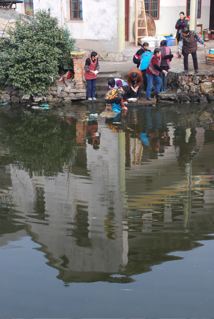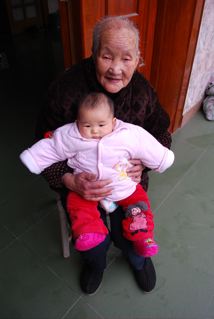Marriage of Identities
During the winter break between my two semesters abroad at Tsinghua University in Beijing, I made the trek to Xiaoshan, an administrative district of Hangzhou, one of southern China’s biggest cities. The occasion for this visit to Xiaoshan was a family member’s wedding. My grandmother’s cousin’s daughter, Chen Xingmei, was getting married to a young man, Chen Xingjiang, whom she met through work and with whom, by chance, she shares two of three characters in her name.
It was my first time visiting Xiaoshan. Although I had been raised by my Chinese parents, I had lived in New York City for all but one year of my life. This trip promised an intimate encounter with my Chinese heritage. To see where my grandmother was from, I could see where I was from.
However, I was in a curious position in Xiaoshan. My Shanghainese speaking parents had hoped that when I returned to my birthplace I would not return as an outsider, but that’s exactly what I was. An apology for not understanding Xiaoshanese was the extent of most interactions I had with my family.
“Rural China was swell,” I wrote to a friend after the trip, “but there’s no way I’m ever again spending four days straight doing nothing else but sitting around waiting to be fed.” Immediately after the trip, I looked back with disappointment. I had been a complete stranger in a place where I thought that I could glimpse part of myself.
My eventual change of heart was prompted by a revisiting of these photographs to remember the richness of Xiaoshan’s visuals. It was during the time I dismissed as time spent “waiting to be fed” when I would experience the intimacy of the bride and groom in their bedroom minutes before they debuted as a couple to their families, and the picturesque buildings that seem out of place in a rural Chinese town. During my time at Xiaoshan I was left alone to roam the town and to venture up the mountains, to contemplate why I was there. And the contemplation took the form of photography.
Photographer John Szarkowski said that the analysis of mirrors and windows is not intended to “divide photography into two parts,” but to “suggest a continuum.” Yet, after giving my photographs a bit of thought, I realized that while Szarkowski’s words were a fine point of departure—they were unsatisfactory. Thinking of mirrors and windows as a continuum would mean that in order for a photograph to successfully be a “mirror” requires that it is not a “window.” As I studied my own photographs, I find that the ones that are most successful as documentaries of other people are the ones that most successfully reflect something internal about me. I abandoned the notion of mirrors and windows being opposite ends of a spectrum. Instead I started to think of my photography as “the window as mirror.”
Of course it would have been more satisfying if I could tell you what these photographs “say” about China. To use the photographs of the vibrant buildings in Xiaoshan as a departure point to discuss Xiaoshan’s rapid development over the recent decades. To tell you that as part of China’s Economic Reform, Xiaoshan has been relegated from a province to a prefecture and eventually to an administrative district of Hangzhou City. That as a result of this absorption, Xiaoshan has been rapidly industrialized.
My grandmother talks of how much Xiaoshan has changed. “Everyone uses western toilets now,” she told me many times during the days leading up to the trip, and continued to remind me of it throughout our stay as though it couldn’t possibly be true. Of the newly built Hangzhou Xiaoshan International Airport and the Hangzhou South Railway Station she spoke about with a sense of loss. To my grandmother toilets were a blessing, but the airports and railways symbolized the sacrifice of Xiaoshan’s quintessence to China’s development. In this sense of displacement, I could relate to my grandmother. She was a stranger in her own land just as I was a stranger in what was supposedly my homeland.
To me, these photographs were a manifestation of my photographic eye in the fleeting moments that I spent in Xiaoshan with my family. To impose a significance on these works about my consideration of larger politics at play in China would be disingenuous. These photographs are primarily an access to my consciousness at a particular place and time, and only secondarily a stance on China’s rural development. These photographs are my access to my feelings at their most raw and essential—they represent that which is “Chinese” and “American” and “urbanization” and “birthplace.” It is only through seeing Xiaoshan photographed that I finally feel that I am in the midst of it.





